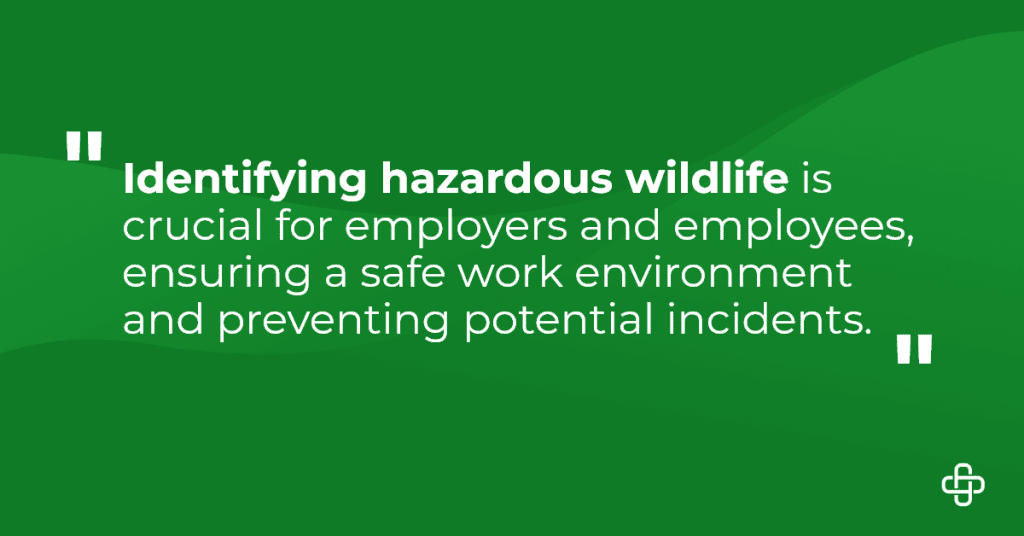Have you provided your workers with the essential training to recognize and handle encounters with hazardous wildlife?
When working outdoors, encountering wildlife is often inevitable. However, not all wildlife is harmless—some can pose significant risks to employees’ safety and well-being.

Identifying hazardous wildlife is crucial for employers and employees, ensuring a safe work environment and preventing potential incidents.
In this blog post, we’ll explore the importance of outdoor safety by identifying hazardous wildlife. We’ll also provide practical tips on recognizing and responding to wildlife encounters safely and best practices for prevention for successful wildlife management.
Common Hazardous Wildlife Encountered in Various Outdoor Work Environments
Different work environments expose outdoor workers to various types of hazardous wildlife. For instance, construction sites, agricultural fields, and forested areas have unique challenges.
Understanding the specific wildlife threats in each environment is essential for effective safety measures.
Snakes and Reptiles
Snakes, especially venomous ones like rattlesnakes or copperheads, are common in rural and forested areas.
Identifying these reptiles by their distinctive markings and sounds can prevent dangerous encounters. It is crucial to educate workers on what to do if they encounter a snake and how to avoid provoking it.
Insects and Arachnids
Insects such as bees, wasps, and hornets can pose serious threats, especially to those allergic to stings. Additionally, spiders like black widows and brown recluses can be hazardous. Recognizing their nests and understanding their behavior can mitigate risks.
Large Mammals
In remote regions, animals such as bears, mountain lions, and wild boars can be encountered. While sightings are rare, knowing how to react calmly and assertively can make all the difference in preventing an attack.
How to Recognize and Respond to Wildlife Encounters Safely
Recognizing hazardous wildlife and responding appropriately is key to minimizing risks. Here are some practical steps:
- Stay Calm and Assess the Situation– The first step when encountering wildlife is to remain calm. Panic can escalate the situation. Assess the distance, the animal’s behavior, and the surroundings before acting.
- Create Distance– Creating distance between yourself and wildlife is crucial. Slowly back away without turning your back on the animal. This signals that you are not a threat. Avoid sudden movements that might provoke an attack.
- Use Deterrents– If the wildlife poses an immediate threat, use deterrents such as loud noises or, if available, bear spray. These can help in discouraging the animal from approaching further.
Best Practices for Preventing Wildlife Incidents in the Workplace
Preventing wildlife incidents requires proactive measures. Implementing these best practices can significantly enhance safety:
• Proper Training and Education: Provide comprehensive training sessions on identifying hazardous wildlife, understanding their behaviors, and learning safety protocols. Regular refresher courses ensure that all employees remain vigilant and informed.
• Safe Work Practices: Encourage safe work practices, such as securing food and garbage, avoiding dense brush and tall grass, and wearing appropriate clothing and protective gear. These simple habits can reduce the likelihood of attracting wildlife.
• Regular Inspections and Maintenance: Regular inspections of the worksite should be conducted to identify potential wildlife habitats. Ensure that vegetation is trimmed and that there are no accessible food sources. Maintenance routines can mitigate the site’s appeal to wildlife.
The Role of Employers and Employees in Creating a Safe Outdoor Work Environment
Creating a safe outdoor work environment is a collective responsibility. Both employers and employees must actively participate:
Employer Responsibilities
Employers should provide the necessary training, equipment, and resources to ensure safety. Regular safety audits and updates on wildlife risks create an informed workforce ready to handle encounters.
Employee Participation
Employees must adhere to the safety protocols, report sightings or incidents promptly, and participate in all training sessions. Active involvement fosters a culture of safety and vigilance.
Resources and Tools for Further Information on Wildlife Safety
Accessing reliable resources and tools can enhance knowledge and preparedness:
- Government Agencies– Organizations such as OSHA and the National Park Service offer guidelines and resources tailored to different work environments. They provide valuable information on wildlife safety and regulations.
- Online Training Programs– Various online platforms offer specialized training programs on wildlife safety. These programs can complement workplace training and provide additional insights.
- Mobile Applications– Several mobile applications provide real-time information on wildlife sightings and behavior. Apps like iNaturalist can be useful tools for workers in the field.
Conclusion and Call to Action
Identifying hazardous wildlife and implementing safety measures are crucial for outdoor work environments. By understanding common hazards, knowing how to respond, and adopting best practices, employers and employees can contribute to a safer workplace.
To help safeguard your workforce, register for Axiom Medical’s upcoming webinar, “Venom Vigilance: Protecting Against Snake and Spider Bites.”
It will be an essential session with practical tips and expert advice to help you stay safe from venomous critters. In this webinar, you will:
- Learn to spot the danger: Identify venomous snakes and spiders.
- Get prevention strategies: Discover effective measures to prevent encounters.
- Master first aid for bites: Gain crucial knowledge on first aid procedures for snake and spider bites.
Sign up now to ensure you are equipped with the necessary skills and information to protect yourself and your team.
Charli Pedersen is a published writer featured on Axiom Medical’s blog. She holds a bachelor’s degree in English, Professional and Technical Writing, and has experience creating content for businesses and non-profit organizations.










